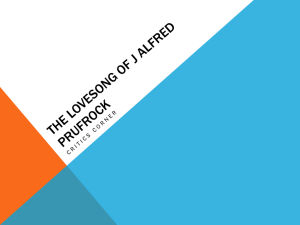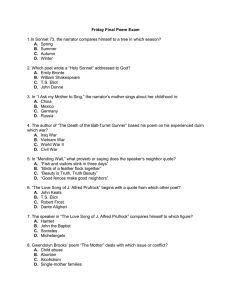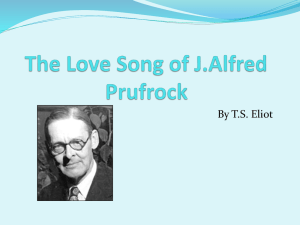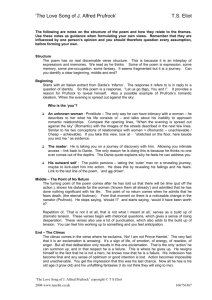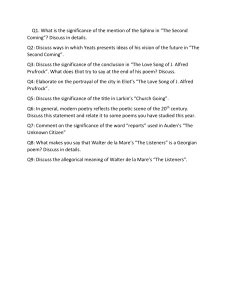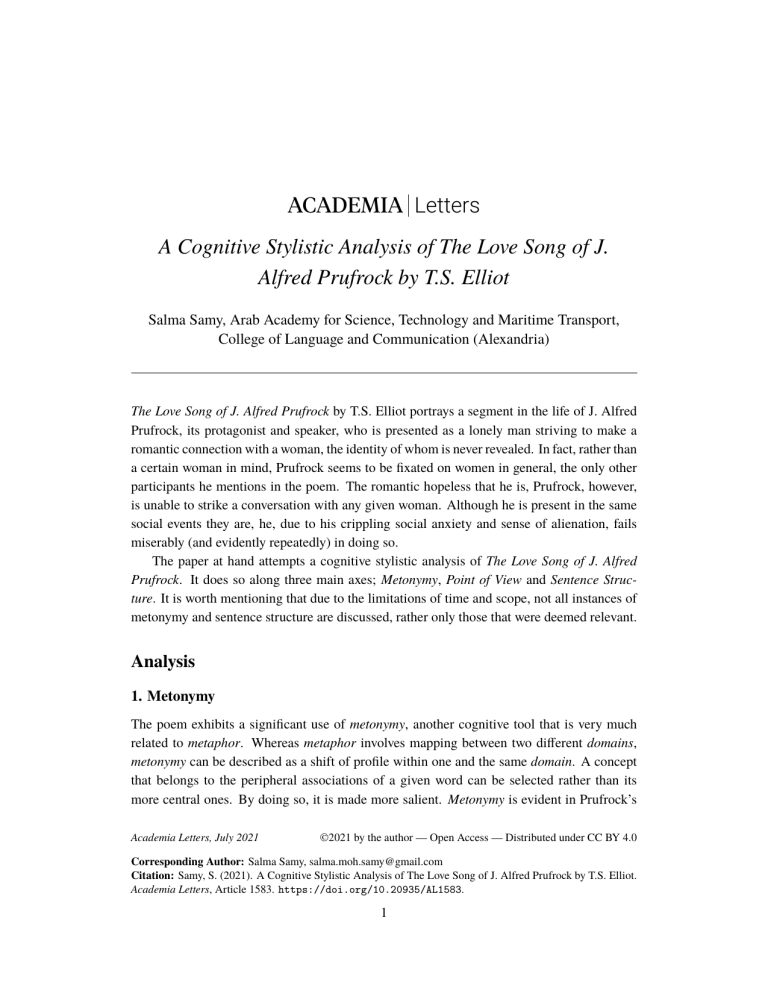
ACADEMIA Letters A Cognitive Stylistic Analysis of The Love Song of J. Alfred Prufrock by T.S. Elliot Salma Samy, Arab Academy for Science, Technology and Maritime Transport, College of Language and Communication (Alexandria) The Love Song of J. Alfred Prufrock by T.S. Elliot portrays a segment in the life of J. Alfred Prufrock, its protagonist and speaker, who is presented as a lonely man striving to make a romantic connection with a woman, the identity of whom is never revealed. In fact, rather than a certain woman in mind, Prufrock seems to be fixated on women in general, the only other participants he mentions in the poem. The romantic hopeless that he is, Prufrock, however, is unable to strike a conversation with any given woman. Although he is present in the same social events they are, he, due to his crippling social anxiety and sense of alienation, fails miserably (and evidently repeatedly) in doing so. The paper at hand attempts a cognitive stylistic analysis of The Love Song of J. Alfred Prufrock. It does so along three main axes; Metonymy, Point of View and Sentence Structure. It is worth mentioning that due to the limitations of time and scope, not all instances of metonymy and sentence structure are discussed, rather only those that were deemed relevant. Analysis 1. Metonymy The poem exhibits a significant use of metonymy, another cognitive tool that is very much related to metaphor. Whereas metaphor involves mapping between two different domains, metonymy can be described as a shift of profile within one and the same domain. A concept that belongs to the peripheral associations of a given word can be selected rather than its more central ones. By doing so, it is made more salient. Metonymy is evident in Prufrock’s Academia Letters, July 2021 ©2021 by the author — Open Access — Distributed under CC BY 4.0 Corresponding Author: Salma Samy, salma.moh.samy@gmail.com Citation: Samy, S. (2021). A Cognitive Stylistic Analysis of The Love Song of J. Alfred Prufrock by T.S. Elliot. Academia Letters, Article 1583. https://doi.org/10.20935/AL1583. 1 description of the women. Rather than referring to them as a whole, Prufrock alludes to parts of them, highlighting in the process the elements which he finds more intriguing. Moreover, it emphasizes his social anxiety; he conceals his interest, of which he is unable to speak, behind referring to mere parts of women, instead of directly and unequivocally addressing it. Prufrock starts by talking first about their faces then moves to describe their voices and eyes in the following lines: (4) To prepare a face to meet the faces that you meet (5) I know the voices dying with a dying fall (6) And I have known the eyes already, known them all— Prufrock’s interest, which starts innocuously with the faces and the voices, turns more sensual, as he metonymically refers to the women’s arms being white and bare in a direct reference to how physically attractive they are. This is further emphasized by his referring to the effect of the women’s perfumes and dresses on him in the following lines: (7) Is it perfume from a dress That makes me so digress? It can be argued that through the different metonymical examples explained above, Prufrock’s longing towards a real romantic connection with a woman is highlighted. By mentioning the faces, the voices and the eyes of the women, as an indication of their personalities, as well as their perfumes, dresses and arms, he seems to yearn for a real connection with a woman, both spiritually and physically. 2. Point of View (Pronouns) According to Hart (2014), promximization is a cognitive tool via which authors are able to reduce or otherwise increase the spatial or temporal conceptual distance between a reader and any given event in the text. He maintains that promximization is achieved using a number of tools, such as diexis, lexical items, and pronouns among others. It can be argued that pronouns in the poem are used significantly to increase or otherwise decrease the conceptual distance between the reader and the characters in the poem, in addition to revealing the view point of its author. Through the use of the first-person pronoun I, Elliot presents a homodiegetic narrative, one in which the protagonist of the story is foregrounded (Simpson, 2004). As readers, we are invited to Prufrock’s thoughts and feelings and we are given full access to these. We are addressed directly using the pronoun you throughout the poem and starting with the very first line (8) Let us go then you and I, Moreover, more than once, both in this instance and elsewhere, such as “Let us go and Academia Letters, July 2021 ©2021 by the author — Open Access — Distributed under CC BY 4.0 Corresponding Author: Salma Samy, salma.moh.samy@gmail.com Citation: Samy, S. (2021). A Cognitive Stylistic Analysis of The Love Song of J. Alfred Prufrock by T.S. Elliot. Academia Letters, Article 1583. https://doi.org/10.20935/AL1583. 2 make our visit”,Prufrock uses an inclusive us and our. In both of these sentences Prufrock explicitly extends an invitation to the reader to explore his world and see it from his own perspective. The repetition of the phrase “Let us go” twice at the very beginning of the poem indicates Pruforck’s desperate state, who makes a plea to us readers to understand and empathize with him. Prufrock’s attempt at decreasing the distance with the reader is contrasted starkly with his own relation with “the women” in the poem. Referring to them as the women using the definite article the first time they are mentioned also creates a sense of familiarity on the part of the reader, as if they already know who he is talking about. This consolidates the idea that Prufrock is reaching out to the reader. The women, however, are depicted as quite distant from Prufrock, though not in terms of physical vicinity (since he is present in the same social events as they are). He uses the third-person pronoun to refer to them in the following sentences: (9) They will say: “How his hair is growing thin!” (10) They will say: “But how his arms and legs are thin!” (11) For I have known them all already, known them all The use of the third-person pronoun to refer to them not only creates distance from Prufrock, but also the reader. From Prufrock’s point of view, any romantic relationship with any one of the women is a far-fetched dream. The agony of not realizing this very much sought after wish is not only experienced by Prufrock, but also by the reader, who shares the same conceptual distance as that former. Not only are the women referred to using the third-person pronouns in examples (9) and (10), but also Prufrock. He uses the third-person pronoun his to refer to himself, further alienating himself from the group. Elsewhere in the poem, Prufrock expresses a crushing feeling of insecurity resulting from his exhibiting physical signs associated with old age in the lines: (12) With a bald spot in the middle of my hair (13) I grow old…I grow old… I shall wear the bottoms of my trousers rolled. It can thus be argued that given the inadequacy Prufrock feels, and the psychological pain associated with the fact that the women are gossiping about how thin and bald he is, he wants to detach himself from their talk. In other words, and in terms of proximization, Prufrock is increasing the distance between the thin, balding, old man they are describing, and himself. Though generally Prufrock depicts his relation with the women as one of silent, distant admiration, there is one instance where he addresses them directly. He used the second-person pronoun you In the line “I am Lazarus, come from the dead,/Come back to tell you all, I shall tell you all”. However validating this line might be to his ego, it seems more of an imagined Academia Letters, July 2021 ©2021 by the author — Open Access — Distributed under CC BY 4.0 Corresponding Author: Salma Samy, salma.moh.samy@gmail.com Citation: Samy, S. (2021). A Cognitive Stylistic Analysis of The Love Song of J. Alfred Prufrock by T.S. Elliot. Academia Letters, Article 1583. https://doi.org/10.20935/AL1583. 3 scenario where he musters up the courage to talk to the woman and overcome his crippling anxiety. Moreover, although he starts with an appreciation of the women in general, he singles out one who sets “a pillow by her head”. This suggests that he might have been infatuated by a particular lady more than her peers. 3. Sentence Structure According to Hart (2014) not only do alternative schematizations affect certain experiences, they are also important tools that can be recruited to construe a scene and assign roles. Grammatical devices, including sentence structure, can be used to code the same situation in different lights, by virtue of the image they impose. The most significantly used sentence structure in this poem is the interrogative. Questions have been used around 17 times in the poem. The sheer number is a reflection of the sense of confusion and loss Prufrock is experiencing. Towards the beginning of the poem, he starts by introducing an overwhelming question, to which he will lead thereader in the line “To lead you to an overwhelming question”. The word “overwhelming” is an indication of his state of mind, clouded by a crushing anxiety and a debilitating sense of inadequacy. The questions enable Prufrock to ask the reader, who by virtue of the second-person pronoun you is directly involved in the events experienced in the poem. As such, the reader is addressed by the following repeated questions: (14) And indeed there will be time To wonder, “Do I dare?” and, “Do I dare?” Do I dare Disturb the universe? Do I dare to eat a peach? (15) So how should I presume? (the bold part is repeated thrice) The sentence structure is significant in that questions warrant an answer, in this case from the reader of the poem. Prufrock is again inviting the reader to be involved in his predicament and in finding solutions to his plight. It can be argued that via repeating his questions, Prufrock is exhibiting a clear sense of desperation, since he is making a plea for help and begs the reader to provide guidance. In conclusion, it is evident from examining some of the cognitive stylistic tools employed in the poem at hand that all of them serve to paint a picture of Prufrock’s debilitating sense of inferiority and social anxiety. The viewpoint expressed in the poem is that of an I-narrator, thus the views are directly that of the speaker. Metonymy and pronouns are used to show proximity, and how distant he is from other characters in the poem—the women—and how Academia Letters, July 2021 ©2021 by the author — Open Access — Distributed under CC BY 4.0 Corresponding Author: Salma Samy, salma.moh.samy@gmail.com Citation: Samy, S. (2021). A Cognitive Stylistic Analysis of The Love Song of J. Alfred Prufrock by T.S. Elliot. Academia Letters, Article 1583. https://doi.org/10.20935/AL1583. 4 close he wants to be to the reader. Such an attempt is an act of desperation towards making human connection. Prufrock invites the reader to his universe not only through pronouns, but also through asking questions, repeatedly, for which he requires a direct answer. All in all, Prufrock is portrayed as a lonely man who is well aware of his shortcomings and his old age. References Hart, C. (2014). Discourse, grammar and ideology: Functional and cognitive perspectives. London: Bloomsbury. Lemmens, M. (2016). Cognitive semantics. In N. Reimer (Ed.), The Routledge handbook of semantics, (pp. 90-105). London: Routledge. Simpson, P. (2004). Stylistics: A resource book for students. London: Routledge. Academia Letters, July 2021 ©2021 by the author — Open Access — Distributed under CC BY 4.0 Corresponding Author: Salma Samy, salma.moh.samy@gmail.com Citation: Samy, S. (2021). A Cognitive Stylistic Analysis of The Love Song of J. Alfred Prufrock by T.S. Elliot. Academia Letters, Article 1583. https://doi.org/10.20935/AL1583. 5
